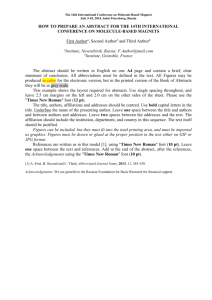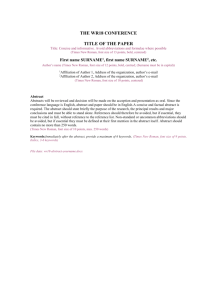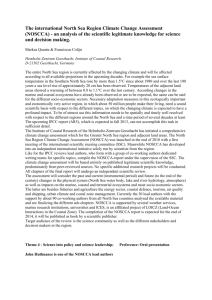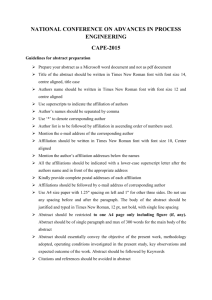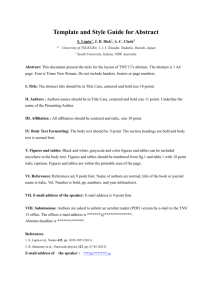Titles should never contain abbreviations, e
advertisement
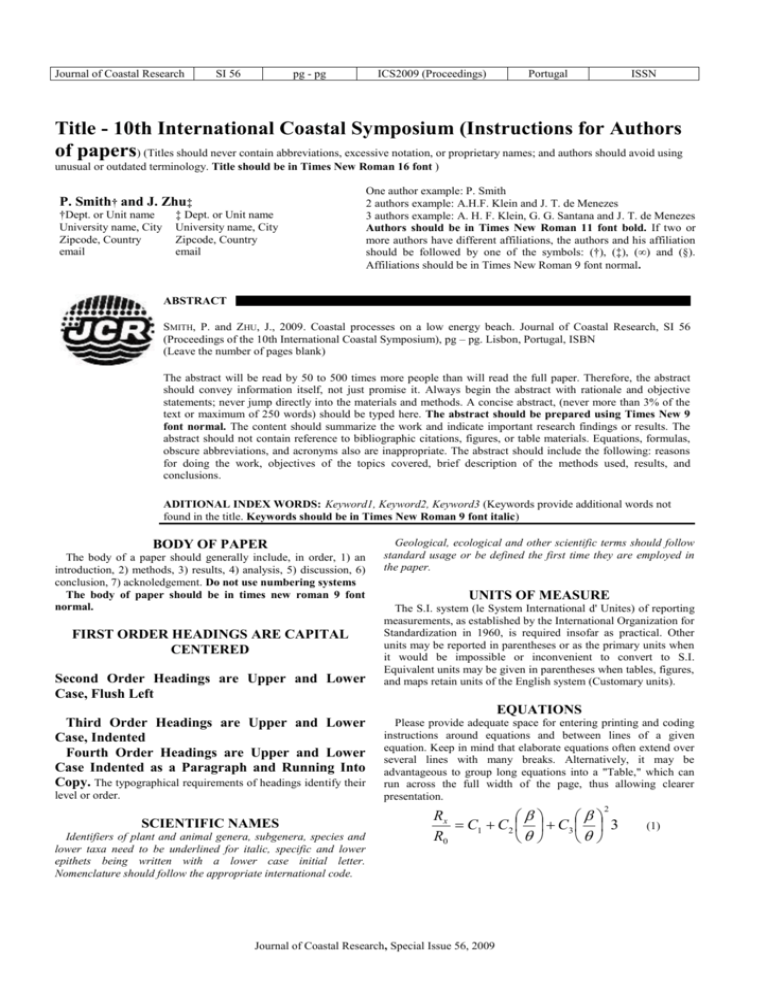
Journal of Coastal Research SI 56 pg - pg ICS2009 (Proceedings) Portugal ISSN Title - 10th International Coastal Symposium (Instructions for Authors of papers) (Titles should never contain abbreviations, excessive notation, or proprietary names; and authors should avoid using unusual or outdated terminology. Title should be in Times New Roman 16 font ) P. Smith† and J. Zhu‡ †Dept. or Unit name University name, City Zipcode, Country email ‡ Dept. or Unit name University name, City Zipcode, Country email One author example: P. Smith 2 authors example: A.H.F. Klein and J. T. de Menezes 3 authors example: A. H. F. Klein, G. G. Santana and J. T. de Menezes Authors should be in Times New Roman 11 font bold. If two or more authors have different affiliations, the authors and his affiliation should be followed by one of the symbols: (†), (‡), (∞) and (§). Affiliations should be in Times New Roman 9 font normal. ABSTRACT SMITH, P. and ZHU, J., 2009. Coastal processes on a low energy beach. Journal of Coastal Research, SI 56 (Proceedings of the 10th International Coastal Symposium), pg – pg. Lisbon, Portugal, ISBN (Leave the number of pages blank) The abstract will be read by 50 to 500 times more people than will read the full paper. Therefore, the abstract should convey information itself, not just promise it. Always begin the abstract with rationale and objective statements; never jump directly into the materials and methods. A concise abstract, (never more than 3% of the text or maximum of 250 words) should be typed here. The abstract should be prepared using Times New 9 font normal. The content should summarize the work and indicate important research findings or results. The abstract should not contain reference to bibliographic citations, figures, or table materials. Equations, formulas, obscure abbreviations, and acronyms also are inappropriate. The abstract should include the following: reasons for doing the work, objectives of the topics covered, brief description of the methods used, results, and conclusions. ADITIONAL INDEX WORDS: Keyword1, Keyword2, Keyword3 (Keywords provide additional words not found in the title. Keywords should be in Times New Roman 9 font italic) BODY OF PAPER The body of a paper should generally include, in order, 1) an introduction, 2) methods, 3) results, 4) analysis, 5) discussion, 6) conclusion, 7) acknoledgement. Do not use numbering systems The body of paper should be in times new roman 9 font normal. FIRST ORDER HEADINGS ARE CAPITAL CENTERED Second Order Headings are Upper and Lower Case, Flush Left Geological, ecological and other scientific terms should follow standard usage or be defined the first time they are employed in the paper. UNITS OF MEASURE The S.I. system (le System International d' Unites) of reporting measurements, as established by the International Organization for Standardization in 1960, is required insofar as practical. Other units may be reported in parentheses or as the primary units when it would be impossible or inconvenient to convert to S.I. Equivalent units may be given in parentheses when tables, figures, and maps retain units of the English system (Customary units). EQUATIONS Third Order Headings are Upper and Lower Case, Indented Fourth Order Headings are Upper and Lower Case Indented as a Paragraph and Running Into Copy. The typographical requirements of headings identify their level or order. Please provide adequate space for entering printing and coding instructions around equations and between lines of a given equation. Keep in mind that elaborate equations often extend over several lines with many breaks. Alternatively, it may be advantageous to group long equations into a "Table," which can run across the full width of the page, thus allowing clearer presentation. Rx C1 C 2 C3 3 R0 2 SCIENTIFIC NAMES Identifiers of plant and animal genera, subgenera, species and lower taxa need to be underlined for italic, specific and lower epithets being written with a lower case initial letter. Nomenclature should follow the appropriate international code. Journal of Coastal Research, Special Issue 56, 2009 (1) Short Running Head (e.g. Beach Management and Safety. Use Times New Roman 9 font normal) Table 1: Structure of standart script of interviews with public users of patrolled beaches (HOEFEL and KLEIN, 1998). Social data Sex Origin Family Income Level of Education Age Group Swimming ability Involvement in bathing accidents Knowledge of the beach Familiarity Frequency of use Depth of sea bathing Potencial signs of danger to sea bathing Precautions taking when getting into water Degree of danger of the sea Precaution taken in relation to children TABLES These will be included in the main body of the manuscript. They should be numbered consecutively, appropriately based, and kept as simple and short as possible. The title to a table should not include the units of measurement or take footnotes. Show the units for all measurements: in spanner heads, in column beads, or in the field. In general, only horizontal rules are used: a double rule at the top, a single rule below the box head, and a single rule at the bottom just over the footnotes; additional horizontal rules may be needed under spanner heads and subheads. Vertical lines within tables should be avoided. The size of a table (for example Tables 1 and 2) can be considered to one column (85 mm) or two columns (175 mm). Captions of a tables should be in Times New Roman 9 font. Tables should be organized on the uper or lower portion of the page. ILUSTRATIONS Photographs and line drawings are to be numbered in Arabic numerals in a single sequence as "Figure l," "Figure 2," etc., and so referred to in the text. Each must be clearly captioned and acknowledged when necessary. The size of a figure (for example Figure 1 and 2), the lettering and lines, must be carefully considered to one column (85 mm) or two columns (175 mm). The length of a column is 230 mm. Larger illustrations may be rotated sideways and printed as a turn-page to take advantage of maximum page size. The minimum size of a reduced letter should be about 2 mm high. Magnifications should be given as bar lines in the photograph and defined in the caption or legend. Maps and planimetric drawings should contain scales in bar lines as well as a north sign. All figures should be mentioned in the text. Figures should not be placed out of numerical order. If this appears necessary, figures should be renumbered. Figures are assumed to be grayscale or black and white (not submitted in color). Captions of figures should be in Times New Roman 9 font normal. Figures should be organized on the uper or lower portion of the page. HOW TO CITE ? Citations are generally treated according to the "Harvard System." In the body of the text, they are cited by naming the author in Small caps (or authors connected by "and" if two or with et al., replacing all names after the first if more than three) and indicating the year of publication. Enclose the cite in parentheses if referring to indirectly, or enclose the year of publication in parentheses if referring to directly, e.g. "(JONES, 1988)" or "(SMITH et al., 1989);" "according to JONES (1988)," "from data prepared by SMITH et al. (1989)." LITERATURE CITED Citations are generally treated according to the "Harvard System." In the body of the text, they are cited by naming the author in SMALL-CAP letters (or authors connected by "and" if two or with et al., replacing all names after the first if more than three) and indicating the year of publication. Enclose the cite in parentheses if referring to indirectly, or enclose the year of publication in parentheses if referring to directly, e.g. "(JONES, 1988)" or "(SMITH et al., 1989);" "according to JONES (1988)," "from data prepared by SMITH et al. (1989)." Papers cited should be grouped together in a list headed "Literature Cited," (not References or Bibliography) alphabetically arranged by first authors' surnames (again, the names should be in Small-Cap letters) but unnumbered, at the end of the body of the paper. There all authors' names and initials are required followed by the date (year) of publication and the full title of the paper. Then follows the full title of the periodical, underlined for italic, then the volume and issue number in Arabic numerals, and finally the page spread. For books, the title is given underlined for italic, and then the bare name of the publisher proceeded by the place (city and state or country) of publication. The list of references should be in Times New Roman 9 font Table 1: Structure of questionnaire for reporting the conditions of bathing accidents, used by lifeguards to register accidents (HOEFEL and KLEIN, 1998). Header Town Beach Post no. Lifeguards Date Time Part A Nature of victim Sex Origin Familiarity and use of the beach Age group Swimming ability Use of drugs Associated lesions Part B: Rescue date Type of rescue Equipment used Locality of rescue Associated danger Fatality or not Observation Journal of Coastal Research, Special Issue 56, 2009 Part C: Beach characteristcs Type of morphology Height of waves Type of waves Cloud cover Wind intensity Current intensity Type of current Author’s last name (e.g. Smith or Smith and Jones or Smith et al. Use Times New Roman 9 font normal) Examples of Reference Formats for the ICS2009 (check the CERF WWW site http://cerfjcr.org/author_instruction-1.htm for additional details) Single-Author Paper in a Journal Dickinson, W.R., 2000. Hydro-isostatic and tectonic influences on emergent Holocene paleoshorelines in the Mariana Islands, western Pacific Ocean. Journal of Coastal Research, 16(3), 735-746 Two-Authored Paper in a Journal Figure 1. An example of a figure considered to one column. (The caption of a figure should be in Times New Roman 9 font) normal. The list of references to journal articles and books, found in the Journal, should be in the following basic format: GIAMMONA, C.P, 1988. Sea surveys. In: Finkl, C.W, Jnr. (ed.), The Encyclopedia of Field and General Geology. New York: Van Nostrand Reinhold, pp. 747-764. MCCAVE, I.N., 1987. Fine sediment sources and sinks around the East Anglian coast (UK). Journal Geological Society London, 144, 149-152. THIEKE, R.J. and HARRIS, PS., 1993. Application of longshore transport statistics to the evaluation of sand transfer alternatives at inlets. Journal of Coastal Research, Special Issue No. 18, pp. 111- 124. KUNDU, PK, 1990. Fluid Dynamics. New York: Academic, 638p. MEHTA, AJ. and MONTAGUE, C.L., 1991. A Brief Review of Flow Circulation in the Vicinity of Natural and Jettied Inlets: Tentative Observations on Implications for Larval Transport at Oregon Inlet, North Carolina. Gainesville, Florida: Oceanographic Engineering Department, University of Florida, Report UFLICOELIMP91 / 03, 74p. Check the accuracy of your references scrupulously. Many papers arrive at a reviewer's desk with incorrect dates, titles, and author names in reference lists; or one year of publication or spelling of the author's name in the reference list and another in the text citation. Responsibility for accuracy rests solely with the author. Examples of variations on the basic citation formula follow. LIDZ, B.H. and HALLOCK, P., 2000. Sedimentary petrology of a declining reef ecosystem, Florida Reef Tract (U.S.A.). Journal of Coastal Research, 16(3), 675-697 Multi-Authored Paper in a Journal MARTINEZ, J.O.; GONZALEZ, J.L.; PILKEY, O.H., and NEAL, W.J., 2000. Barrier island evolution on the subsiding central Pacific Coast, Colombia, S.A. Journal of Coastal Research, 16(3), 663-674. Paper in a Proceedings Volume with No Editor BUTENKO, J and BARBOT, J.P., 1980. Geological hazards related to offshore drilling and construction in the Oronoco River Delta of Venezuela. Offshore Technology Conference (Houston, Texas), Paper 3395, pp. 323-329. UDA, T. and Hashimoto, H., 1982. Description of beach changes using an empirical predictive model of beach profile changes. Proceedings of the 18th Conference of Coastal Engineering (Cape Town, South Africa, ASCE), pp. 1405-1418. GODA, Y., 1970. The observed joint distribution of periods and heights of sea waves. Proceedings of the 16th International Conference on Coastal Engineering (Sydney, New South Wales, Australia), pp. 227-246. Book Commercial Publisher COLEMAN, J.M., 1981. Deltas: Processes of Deposition and Models for Exploration. Boston, Massachusetts: International Human Resources Development Corporation, 121p ROBERTS, N., 1989. The Holocene, an Environmental History. Malden, Massachusetts: Blackwell, 316p. Government Publisher FISK, H.N., 1944. Geological Investigations of the Alluvial Valley of the Lower Mississippi River. Vicksburg, Mississippi: U.S. Figure 2. An example of a figure considered to two columns Journal of Coastal Research, Special Issue 56, 2009 Short Running Head (e.g. Beach Management and Safety. Use Times New Roman 9 font normal) Army Corps of Engineers, Mississippi River Commission, 78p. University Press DIAZ, H.F. and MARKGRAF, V., (eds.), 1992. El Niño Historical and Paleoclimatic Aspects of the Southern Oscillation. New York: Cambridge University Press, 321p. Chapter in an Edited Book COLIN, C. and BOURLES, B., 1992. Western boundary currents in front of French Guiana. In: PROST, M.T. (ed.), Évolution des littoraux de Guyane et de la zone Carïbe méridonale pedant le Quaternaire. Paris, France: Editions de l'ORSTOM Institute Française de Recherche Scientifique pour la Développment en Coopération, pp. 73-91. With No Specified Author McClelland Engineering Staff, 1979. Interpretation and Assessment of Shallow Geologic and Geotechnical Conditions. Caracas, Venezuela: McClelland Engineering, Inc., Orinoco Regional Survey Areas, Offshore Orinoco Delta, Venezuela, Volume 1, 109p. U.S. Environmental Protection Agency Staff, 1994. The Long Island Sound Study: Summary of the Comprehensive Conservation and Management Plan. Washington, DC: U.S. Environmental Protection Agency Publication, EPA 842-S-94001, 62p. Theses and Dissertations WORTHY, M.C., 1980. Littoral Zone Processes at Old Woman Creek Estuary of Lake Erie. Columbus, Ohio: Ohio State University, Master's thesis, 198p. ARENS, S.M., 1996. Aeolian Procresses in the Dutch Foredunes. Amsterdam, The Netherlands: University of Amsterdam, Ph.D. thesis, 150p. Special Issues of a Journal WARNE, A.G. and STANLEY, D.J., 1995. Sea-level change as a critical factor in development of basin margin sequences: new evidence from late Quaternary record. In: FINKL, C.W. (ed.), Holocene Cycles: Climate, Sea Levels, and Sedimentation. Journal of Coastal Research Special Issue No. 17, pp. 231240. [N.B. Special issues can also be treated like a book because they are discrete and unrelated to each other in a series. The issue should be specified. Maps or Charts BELTRÁN, C., 1993. Mapa neotectónico de Venezuela. Caracas, Venezuela: FUNVISIS Departmento de Ciencias de la Tierra, scale 1:2,000,000, 1 sheet. ACKNOLEDGEMENT New affiliations, contribution numbers from institutions, and financial support from research contracts and grants may be added here. Journal of Coastal Research, Special Issue 56, 2009

